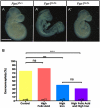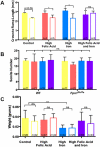High levels of iron supplementation prevents neural tube defects in the Fpn1ffe mouse model
- PMID: 28008752
- PMCID: PMC5388561
- DOI: 10.1002/bdra.23542
High levels of iron supplementation prevents neural tube defects in the Fpn1ffe mouse model
Abstract
Background: Periconception maternal nutrition and folate in particular are important factors influencing the incidence of neural tube defects (NTDs). Many but not all NTDs are prevented by folic acid supplementation and there is a pressing need for additional strategies to prevent these birth defects. Other micronutrients such as iron are potential candidates, yet a clear role for iron deficiency in contributing to NTDs is lacking. Our previous studies with the flatiron (ffe) mouse model of Ferroportin1 (Fpn1) deficiency suggest that iron is required for neural tube closure and forebrain development raising the possibility that iron supplementation could prevent NTDs.
Methods: We determined the effect of periconception iron and/or folic acid supplementation on the penetrance of NTDs in the Fpn1ffe mouse model. Concurrently, measurements of folate and iron were made to ensure supplementation had the intended effects.
Results: High levels of iron supplementation significantly reduced the incidence of NTDs in Fpn1ffe mutants. Fpn1 deficiency resulted in reduced folate levels in both pregnant dams and embryos. Yet folic acid supplementation did not prevent NTDs in the Fpn1ffe model. Similarly, forebrain truncations were rescued with iron. Surprisingly, the high levels of iron supplementation used in this study caused folate deficiency in wild-type dams and embryos.
Conclusion: Our results demonstrate that iron supplementation can prevent NTDs and forebrain truncations in the Fpn1ffe model. Surprisingly, high levels of iron supplementation and iron overload can cause folate deficiency. If iron is essential for neural tube closure, it is possible that iron deficiency might contribute to NTDs. Birth Defects Research 109:81-91, 2017. © 2016 The Authors Birth Defects Research Published by Wiley Periodicals, Inc.
Keywords: exencephaly; folic acid supplementation; iron deficiency; neural tube defects; spina bifida.
© 2016 The Authors Birth Defects Research Published by Wiley Periodicals, Inc.
Figures





Similar articles
-
Prevention of neural tube defects in Lrp2 mutant mouse embryos by folic acid supplementation.Birth Defects Res. 2017 Jan 20;109(1):16-26. doi: 10.1002/bdra.23589. Birth Defects Res. 2017. PMID: 27883261 Free PMC article.
-
Inositol, neural tube closure and the prevention of neural tube defects.Birth Defects Res. 2017 Jan 30;109(2):68-80. doi: 10.1002/bdra.23533. Birth Defects Res. 2017. PMID: 27324558 Free PMC article. Review.
-
The iron exporter ferroportin 1 is essential for development of the mouse embryo, forebrain patterning and neural tube closure.Development. 2010 Sep;137(18):3079-88. doi: 10.1242/dev.048744. Epub 2010 Aug 11. Development. 2010. PMID: 20702562 Free PMC article.
-
Maternal dietary uridine causes, and deoxyuridine prevents, neural tube closure defects in a mouse model of folate-responsive neural tube defects.Am J Clin Nutr. 2015 Apr;101(4):860-9. doi: 10.3945/ajcn.114.097279. Epub 2015 Jan 28. Am J Clin Nutr. 2015. PMID: 25833982 Free PMC article.
-
Nutritional role of folate.Congenit Anom (Kyoto). 2017 Sep;57(5):138-141. doi: 10.1111/cga.12233. Epub 2017 Jul 25. Congenit Anom (Kyoto). 2017. PMID: 28603928 Review.
Cited by
-
Micronutrient imbalance and common phenotypes in neural tube defects.Genesis. 2021 Nov;59(11):e23455. doi: 10.1002/dvg.23455. Epub 2021 Oct 19. Genesis. 2021. PMID: 34665506 Free PMC article. Review.
-
Parental metal exposures as potential risk factors for spina bifida in Bangladesh.Environ Int. 2021 Dec;157:106800. doi: 10.1016/j.envint.2021.106800. Epub 2021 Aug 3. Environ Int. 2021. PMID: 34358915 Free PMC article.
-
Snx3 is important for mammalian neural tube closure via its role in canonical and non-canonical WNT signaling.Development. 2020 Nov 19;147(22):dev192518. doi: 10.1242/dev.192518. Development. 2020. PMID: 33214242 Free PMC article.
-
Pathogenesis of neural tube defects: The regulation and disruption of cellular processes underlying neural tube closure.WIREs Mech Dis. 2022 Sep;14(5):e1559. doi: 10.1002/wsbm.1559. Epub 2022 May 3. WIREs Mech Dis. 2022. PMID: 35504597 Free PMC article. Review.
-
Prevention of neural tube defects in Lrp2 mutant mouse embryos by folic acid supplementation.Birth Defects Res. 2017 Jan 20;109(1):16-26. doi: 10.1002/bdra.23589. Birth Defects Res. 2017. PMID: 27883261 Free PMC article.
References
-
- Acampora D, Avantaggiato V, Tuorto F, Briata P, Corte G, Simeone A. Visceral endoderm-restricted translation of Otx1 mediates recovery of Otx2 requirements for specification of anterior neural plate and normal gastrulation. Development. 1998;125:5091–5104. - PubMed
-
- Arakawa T, Ohara K, Kakizaki R, Takahashi Y, Hirata K, Fujii M, Konno T, Morikawa T, Chiba F, Chiba R. Folic acid deficiency in hemochromatosis: probably due to a defective storage of folic acid in the liver. The Tohoku journal of experimental medicine. 1965;86:301–306. - PubMed
-
- Bothwell TH. Iron requirements in pregnancy and strategies to meet them. The American journal of clinical nutrition. 2000;72:257S–264S. - PubMed
-
- Buamah PK, Russell M, Bates G, Ward AM, Skillen AW. Maternal zinc status: a determination of central nervous system malformation. British journal of obstetrics and gynaecology. 1984;91:788–790. - PubMed
Publication types
MeSH terms
Substances
Grants and funding
LinkOut - more resources
Full Text Sources
Other Literature Sources
Medical
Molecular Biology Databases

